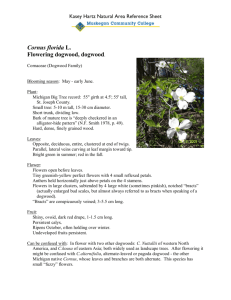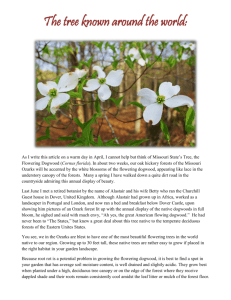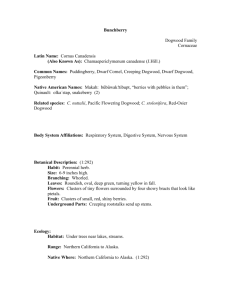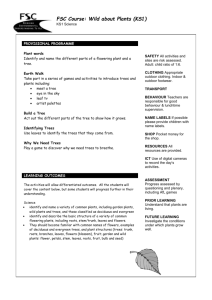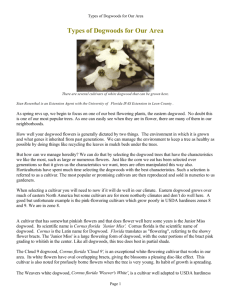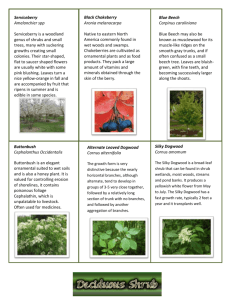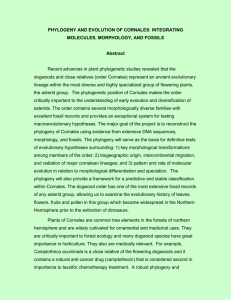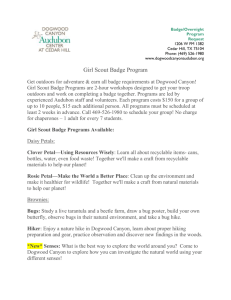flowering dogwood - Indiana Native Plant & Wildflower Society
advertisement
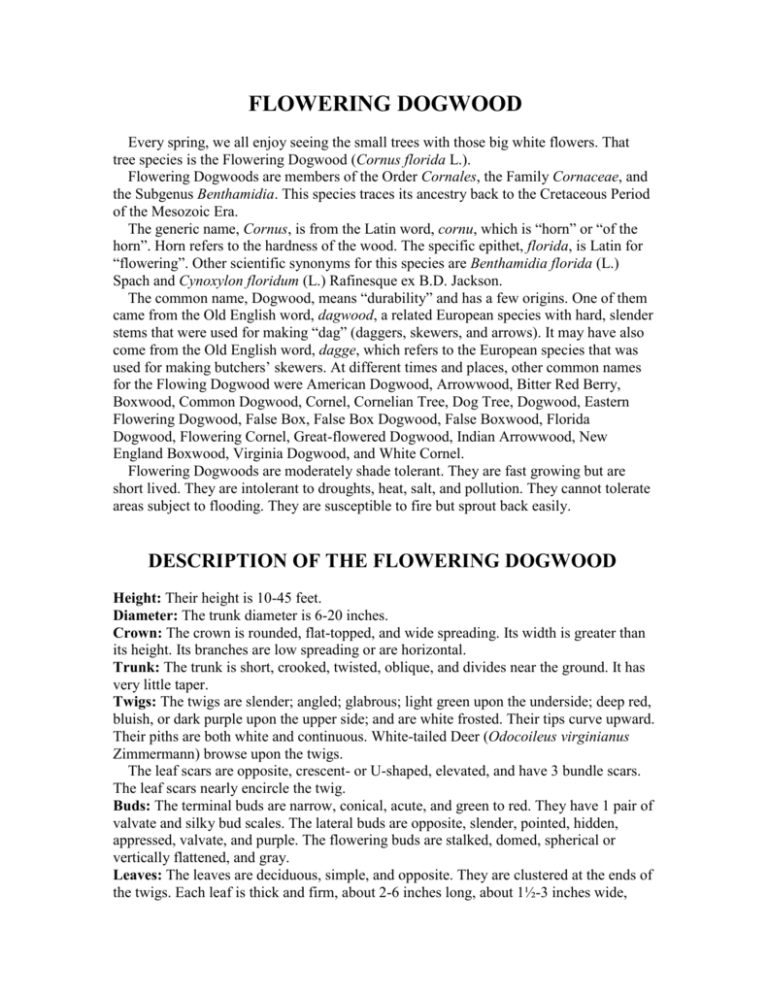
FLOWERING DOGWOOD Every spring, we all enjoy seeing the small trees with those big white flowers. That tree species is the Flowering Dogwood (Cornus florida L.). Flowering Dogwoods are members of the Order Cornales, the Family Cornaceae, and the Subgenus Benthamidia. This species traces its ancestry back to the Cretaceous Period of the Mesozoic Era. The generic name, Cornus, is from the Latin word, cornu, which is “horn” or “of the horn”. Horn refers to the hardness of the wood. The specific epithet, florida, is Latin for “flowering”. Other scientific synonyms for this species are Benthamidia florida (L.) Spach and Cynoxylon floridum (L.) Rafinesque ex B.D. Jackson. The common name, Dogwood, means “durability” and has a few origins. One of them came from the Old English word, dagwood, a related European species with hard, slender stems that were used for making “dag” (daggers, skewers, and arrows). It may have also come from the Old English word, dagge, which refers to the European species that was used for making butchers’ skewers. At different times and places, other common names for the Flowing Dogwood were American Dogwood, Arrowwood, Bitter Red Berry, Boxwood, Common Dogwood, Cornel, Cornelian Tree, Dog Tree, Dogwood, Eastern Flowering Dogwood, False Box, False Box Dogwood, False Boxwood, Florida Dogwood, Flowering Cornel, Great-flowered Dogwood, Indian Arrowwood, New England Boxwood, Virginia Dogwood, and White Cornel. Flowering Dogwoods are moderately shade tolerant. They are fast growing but are short lived. They are intolerant to droughts, heat, salt, and pollution. They cannot tolerate areas subject to flooding. They are susceptible to fire but sprout back easily. DESCRIPTION OF THE FLOWERING DOGWOOD Height: Their height is 10-45 feet. Diameter: The trunk diameter is 6-20 inches. Crown: The crown is rounded, flat-topped, and wide spreading. Its width is greater than its height. Its branches are low spreading or are horizontal. Trunk: The trunk is short, crooked, twisted, oblique, and divides near the ground. It has very little taper. Twigs: The twigs are slender; angled; glabrous; light green upon the underside; deep red, bluish, or dark purple upon the upper side; and are white frosted. Their tips curve upward. Their piths are both white and continuous. White-tailed Deer (Odocoileus virginianus Zimmermann) browse upon the twigs. The leaf scars are opposite, crescent- or U-shaped, elevated, and have 3 bundle scars. The leaf scars nearly encircle the twig. Buds: The terminal buds are narrow, conical, acute, and green to red. They have 1 pair of valvate and silky bud scales. The lateral buds are opposite, slender, pointed, hidden, appressed, valvate, and purple. The flowering buds are stalked, domed, spherical or vertically flattened, and gray. Leaves: The leaves are deciduous, simple, and opposite. They are clustered at the ends of the twigs. Each leaf is thick and firm, about 2-6 inches long, about 1½-3 inches wide, ovate to broadly elliptical, has an abruptly pointed tip and a tapered base, is bright dark green above and light green and slightly hairy below, and has entire or slightly wavy margins. This leaf has a central midvein with 5-7 impressed, curving, parallel, lateral veins on each side that are arcuate (nearly parallel to the leaf margin). When the leaves split apart, latex-like threads appear in the veins. The petioles are about ½-¾ inch long and are grooved. There are no stipules. White-tailed Deer eat these leaves. These leaves turn bright red, red-brown, purple, orange, bronze, or yellow in the fall. They turn early and retain their fall colors for an extended period. When these leaves drop in the fall, they decompose quickly. They decompose 3 times faster than Hickories (Genus Carya), 4 times faster than Tuliptrees (Liriodendron tulipifera L.) and White Ashes (Fraxinus americana L.), and 10 times faster than Oaks (Genus Quercus) and American Sycamores (Platanus occidentalis L.). These leaves contain lots of calcium plus fluorine, magnesium, phosphorous, potassium, and sulfur. They also contain minor elements, such as boron, copper, iron, and zinc. These minerals are added to the soil and are used by other plants or by invertebrates. Flowers: The flowers are tightly packed into small, dense, umbelled, greenish yellow to creamy white, clustered heads of 15-30 stemless flowers. These heads are about ½-¾ inches wide. Each flower is radially symmetrical, has a 4-lobed calyx, a 4-petalled corolla, 4 stamens that alternate with the petals, and a 2-celled ovary. Each flower is arranged upon a short, stout peduncle. Four large, rounded, broadly elliptical, white petal-like bracts surround these clusters. These bracts are expanded flower bud scales. Each bract is about ¾-4 inches long; has soft, parallel, greenish veins; and has notches at its greenish or reddish tip. Some cultivated varieties have pink or reddish bracts. These 4 bracts form a cross. These flowers are insect-pollinated. The bracts guide the insects to the flowers. Only a few flowers in each cluster are fertilized to become fruits. These trees will produce flowers after 6 years of age. Flowering season is March to June. They may bloom before the leaves unfold. They retain their bloom for 2-3 weeks. Fruits: The mature fruits are shiny, scarlet red (rarely yellow with a rosy blush) drupes (not berries). Each fruit is elliptical, oblong, ovate, or ovoid, and is ½ inch long and ¼ inch wide. These fruits are located at ends of long stalks and are arranged in close clusters of 2-10. The fruits are composed of a thin, mealy pulp. These fruits contain about 24% fat by weight. About 86 species of birds eat these fruits. Some mammal species, such as Virginia Opossums (Didelphis virginiana Kerr), Squirrels (Family Sciuridae), Eastern Cottontail Rabbits (Sylvilagus floridanus J.A. Allen), Striped Skunks (Mephitis mephitis Schreber), Raccoons (Procyon lotor L.), and White-tailed Deer also eat these fruits. These fruits persist throughout winter. Fruiting season is August to November. Seeds: Each fruit has 1-2 nutlet seeds. Each seed is oval, hard, grooved, and has pointed pits. These seeds are spread by birds and germinate in the spring after 2 years. These trees produce abundant seed crops every 2 years. Bark: The young bark is smooth and light gray. The older bark is scaly and rough. Its color is dark red-brown, dark brown, dark gray, or black. Its blocky, plate-like scales are either rounded or are squared. If damaged, this bark heals very slowly. Wood: The wood is hard, heavy, tough, strong, diffuse-porous, and close-grained. Its heartwood is dark brown, light red-brown, or greenish. Its sapwood is both wider and pinkish or lighter in color. It is subject to rot and decay. Roots: The roots are deep and widespread. Habitat: Their habitat consists of mesic to dry acidic upland woods, old fields, fencerows, and roadsides. It prefers rich, well-drained soils. It is an understory tree that tolerates a variety of habitats. It is also a climax forest tree species. Range: Flowering Dogwood is found in most of the eastern U.S., except northern New England, the northern Great Lakes, and most of Florida. In the north, its western limit is Illinois. In the south, its western limit is Kansas, Oklahoma, and Texas. It is not readily found in the Mississippi River valley. Its range has expanded after the Europeans arrived and cut down much of the eastern forests. Uses of the Flowering Dogwood: Flowering Dogwoods had different uses from different parts of the tree. Both the Native Americans and the early European settlers used this tree. The wood is shock-resistant, is able to withstand abrasion, and wears smoothly under friction. This wood was used for barrel hoops, bobbins, farm implements, golf club heads, hayforks, knitting needles, mallet heads, mauls, pulleys, rake teeth, rolling pins, sledge runners, splitting wedges, tool handles, weaving shuttles, wheel cogs, and wheel hubs. The powdered bark is used as toothpaste, as black ink when mixed with iron sulfate, and as a quinine substitute. This quinine substitute was used in the South during the Civil War after the North had set up naval blockades around the southern ports. Both the inner bark and the root bark were used as an antiseptic, an astringent, a cathartic, a diaphoretic, a febrifuge, a stimulant, and a tonic. The bark is boiled into a tea and was used for treating cancer, cholera, colic, dysentery, dyspepsia, fevers, hepatitis, hysteria, intestinal worms, jaundice, liver ailments, malaria (ague), sore mouths, and typhus. The bark was also used as a poultice for treating sores or external ulcers. The bark contains the glucoside cornine, betalic acid, gallic acid, tannic acid, verberalin, and verbenalosida. They were also used as a scarlet red dye. Many physicians used these medicines from the bark. They were listed in the U.S. Pharmacopoeia from 1820 to 1894 and in the National Formulary from 1916 to 1936. The twigs’ chewed split ends make good toothbrushes. An 1830 herbal report said it was highly effective in whitening the teeth of Native Americans and of African Slaves. The twigs’ juices both preserve and harden the gums. Like hard-bristled toothbrushes, these twigs can cause receding gums. The fruit, which is bitter and toxic to humans, was soaked in brandy. It was used as a bitter tonic for excess stomach acids. The fruit was also mixed with other fruits to make jams and jellies. The trees are highly valued as ornamental landscaping plants. There are over 120 different cultivars and varieties of this species. Dogwood Anthracnose and Other Threats: Flowering Dogwoods face many threats. Perhaps their greatest threat is Dogwood Anthracnose (Discula destructiva). This fungal disease first arrived in the United States during the early 1970’s. It like came to American from Asia through infected nursery stocks of Asian Dogwoods (Cornus kousa Buerger ex Miquel). It is more prevalent in the East and the West than in the Midwest. This disease probably spread through bird droppings. The earliest symptoms to appear are brown or tan blotches with purple edges upon the leaves. These blotches enlarge and cause blighted leaves. Eventually the disease progresses through the petioles and the twigs to the shoots. The disease forms stem lesions at the leaf nodes. Cankers later form upon the trunk to girdle the tree. The tree dies in 2-3 years. Trees that grow in shade and sunlight with open-air circulation have been spared this disease. Scientists are seeking ways to control this disease and to cultivate resistant hybrids. Flowering Dogwoods face other threats as well. Some of their other diseases are Spot Anthracnose (Elsinoe corni), and Powdery Mildews (Microsphaeria pennicillata) and (Phyllactinin guttata). Some of their insect pests include Dogwood Borers (Synthedia scitula), Dogwood Twig Borers (Oberea tripunctata), and Dogwood Sawflies (Macrenphytus tursatus). Cultural History: Flowering Dogwoods have some cultural history. This tree has been cultivated since 1680. Several of our Presidents have admired this tree and have planted them at the White House or upon their own private estates. George Washington planted them at Mount Vernon and Thomas Jefferson planted them at Monticello. Dogwoods are also mentioned in some legends. According to one legend, all Dogwood species were once as tall and as straight as the Oaks. When a Eurasian Dogwood species was used as the cross for the crucifixion of Jesus Christ, the tree became ashamed of its use. Because of its shame, Christ decreed that all Dogwood tree species would be small and crooked. Therefore, they could not be used as crosses. Although, the trees are not used as crosses, the Flowering Dogwood flowers, which bloom around Easter, would symbolize the crucifixion. The 4 bracts symbolize the cross, the bracts’ notches symbolize the nails, and the flower heads symbolize the thorn crown. REFERENCES MICHIGAN TREES By Burton V. Barnes and Warren H. Wagner, Jr. FALL COLOR AND WOODLAND HARVESTS By C. Ritchie Bell and Anne H. Lindsey TREES OF NEW YORK STATE By H. P. Brown DOGWOODS By Paul Cappiella and Don Shadow THE BOOK OF FOREST AND THICKET By John Eastman and Amelia Hansen MEDICINAL AND OTHER USES OF NORTH AMERICAN PLANTS By Charlotte Erichsen-Brown TREES OF PENNSYLVANIA AND THE NORTHEAST By Charles Fergus and Amelia Hansen EASTERN/CENTRAL MEDICINAL PLANTS AND HERBS By Steven Foster and James A. Duke TREES OF THE EASTERN AND CENTRAL UNITED STATES AND CANADA By William M. Harlow 101 TREES OF INDIANA By Marion T. Jackson MEDICINAL PLANTS OF THE HEARTLAND By Connie Kaye and Neil Billington TREES OF ILLINOIS By Linda Kershaw NATIONAL WILDLIFE FEDERATION FIELD GUIDE TO TREES OF NORTH AMERICA By Bruce Kersher, Daniel Mathews, Gil Nelson, and Richard Spallenberg A FIELD GUIDE TO MEDICINAL PLANTS By Arnold and Connie Krochmal TREES OF THE CENTRAL HARDWOOD FORESTS OF NORTH AMERICA By Daniel J. Leopold, William C. McComb, and Robert N. Muller NATIONAL AUDUBON SOCIETY FIELD GUIDE TO NORTH AMERICAN TREES (EASTERN REGION) By Elbert L. Little THE FOLKLORE OF TREES AND SHRUBS By Laura C. Martin HOW TO KNOW THE TREES By Howard A. Miller and H.E. Jaques TREES By Robert H. Mohlenbrock and John W. Thieret A NATURAL HISTORY OF TREES OF EASTERN AND CENTRAL NORTH AMERICA By Donald Culross Peattie TREES AND SHRUBS By George A. Petrides THE URBAN TREE BOOK By Arthur Plotnik EDIBLE AND USEFUL WILD PLANTS OF THE UNITED STATES AND CANADA By Charles Francis Saunders OHIO TREES By T. Davis Sydnor and William F. Cowen NATIONAL AUDUBON SOCIETY FIELD GUIDE TO WILDFLOWERS (EASTERN REGION) By John W. Thieret, William A. Niering, and Nancy C. Olmstead WINTER BOTANY By William Trelease AMERICAN INDIAN MEDICINE By Virgil J. Vogel NATIVE TREES OF THE MIDWEST By Sally S. Weeks, Harmon P. Weeks, Jr., and George R. Parker EARTH MEDICINE EARTH FOOD By Michael A. Weiner en.wikipedia.org/wiki/Cornus_florida
